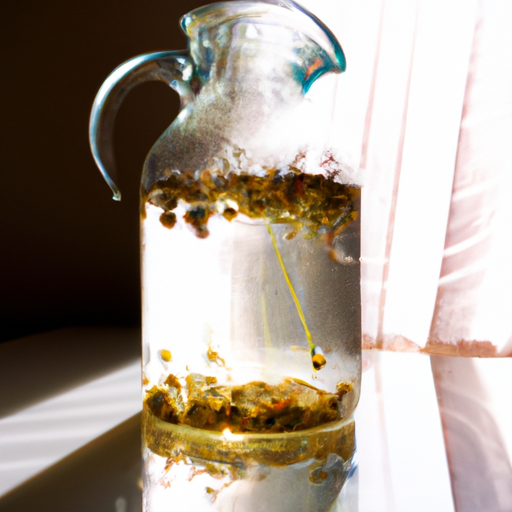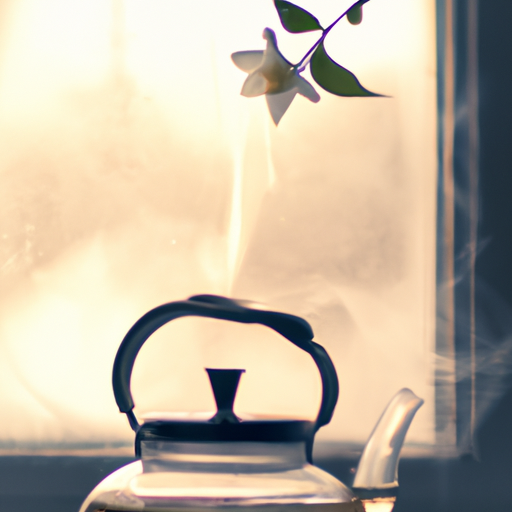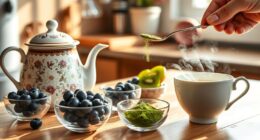Have you ever wanted to experience the soothing benefits of chamomile in a refreshing iced tea? Well, you’re in luck! In this article, I will guide you through the process of making a delicious dried chamomile flower infusion for iced tea.
Chamomile, known for its calming properties, has been used for centuries to promote relaxation and improve sleep. By infusing dried chamomile flowers in boiling water and then combining it with a homemade iced tea base, you can create a delightful beverage that will not only quench your thirst but also provide a sense of tranquility.
So, gather your ingredients and tools, follow the simple steps I will outline, and get ready to savor a refreshing and soothing chamomile flower infusion in the form of a delicious iced tea.
Key Takeaways
- Chamomile tea is known for its calming properties and can promote relaxation and improve sleep.
- Dried chamomile flowers can be infused in boiling water to create a soothing chamomile tea.
- Chamomile tea has numerous health benefits, including reducing anxiety, aiding digestion, boosting the immune system, and promoting overall well-being.
- Properly drying and storing chamomile infusion allows for long-term enjoyment and experimentation with different flavors and storage methods.
Introduction to Chamomile and its Benefits
Get ready to discover the wonders of chamomile and all the incredible benefits it has to offer!
Chamomile tea is not only delicious and refreshing, but it also comes with a plethora of health benefits. Known for its calming properties, chamomile tea can help reduce anxiety and promote better sleep. It’s also a great natural remedy for digestive issues, such as bloating and indigestion. Additionally, chamomile tea is packed with antioxidants that can boost your immune system and promote overall well-being.
Now that you know about the amazing benefits of chamomile tea, let’s dive into some delicious recipes that you can try. From classic chamomile tea to chamomile-infused iced tea, the possibilities are endless. You can even experiment with adding different flavors like lemon or honey to enhance the taste.
Before we get started, let’s gather the ingredients and tools needed to make your own dried chamomile flower infusion for iced tea.
Gathering the Ingredients and Tools
Firstly, you’ll need to gather all the necessary ingredients and tools for creating a refreshing and soothing iced beverage using dried chamomile flowers. To start, you’ll need a handful of dried chamomile flowers. Make sure to choose high-quality, organic flowers for the best flavor and benefits.
You can find dried chamomile flowers at your local health food store or online. Additionally, you’ll need a teapot or a heat-resistant container to steep the flowers in hot water. A strainer or a tea infuser will come in handy for separating the flowers from the infusion.
For the iced tea, you’ll need a pitcher to hold the final beverage and a stirrer to mix in any sweeteners or additional ingredients. Lastly, don’t forget to have some ice cubes ready to chill the tea.
Once you have gathered all the tools and ingredients, you can move on to the next section about preparing the dried chamomile flowers without losing any time.
Preparing the Dried Chamomile Flowers
To start preparing your refreshing and soothing beverage, you’ll need to steep the high-quality, organic chamomile flowers in hot water using a teapot or a heat-resistant container. Did you know that chamomile has been used for centuries for its calming properties, helping to reduce stress and anxiety?
To ensure the best flavor and potency in your dried chamomile flower infusion, it’s important to properly prepare the flowers. Here are the drying methods and health benefits you should know:
-
Air drying: Hang the chamomile flower stems upside down in a cool, dry place for about 1-2 weeks. This method helps preserve the flowers’ natural oils and aroma.
-
Dehydrator: If you have a food dehydrator, spread the chamomile flowers on the trays and set the temperature to around 95°F (35°C) for 2-3 hours. This method allows for a quicker drying process.
-
Health benefits: Chamomile is known for its soothing effects, aiding in relaxation and promoting better sleep. It also has anti-inflammatory properties and may help with digestive issues.
Now that your chamomile flowers are properly dried, we can move on to the next step: boiling water and steeping the chamomile.
Boiling Water and Steeping the Chamomile
Once your dried chamomile flowers are ready, it’s time to bring a pot of water to a rolling boil and immerse the fragrant flowers, allowing them to steep and release their calming essence. Boiling water is a common and effective technique for making herbal infusions. The heat helps to extract the flavors and beneficial compounds from the chamomile flowers, ensuring a potent and flavorful infusion.
To begin, fill a pot with water and place it on the stove over high heat. Wait for the water to come to a rolling boil, where large bubbles are consistently forming and breaking on the surface. Once the water is boiling, carefully add the dried chamomile flowers. Use a ratio of 1 tablespoon of flowers for every 8 ounces of water, adjusting the amount according to your personal preference.
Allow the chamomile flowers to steep in the boiling water for about 5 minutes. This duration is ideal for extracting the maximum flavor and benefits from the flowers. However, if you prefer a stronger infusion, you can extend the steeping time by a few minutes. Alternatively, you can experiment with other steeping methods, such as using a French press or an infuser ball.
Now that the chamomile flowers have had a chance to infuse the boiling water with their soothing properties, it’s time to move on to the next step of straining and cooling the infusion.
Straining and Cooling the Infusion
After steeping the chamomile flowers in boiling water, strain the fragrant liquid into a separate container and let it cool before enjoying. Straining the infusion is an important step to remove any leftover flower particles and ensure a smooth and pure tea.
There are different straining techniques you can use, depending on your preference. You can use a fine mesh strainer or a cheesecloth to strain the liquid, ensuring no solids remain. Another alternative is using a tea infuser or a tea bag to hold the flowers while steeping, making the straining process easier.
Once strained, let the chamomile infusion cool to room temperature. You can speed up the cooling process by placing the container in the refrigerator for around 30 minutes. Alternatively, if you’re in a hurry, you can pour the infusion over a glass filled with ice cubes to quickly chill it. Remember that the longer the infusion cools, the stronger the flavor will become.
Now that you have a perfectly strained and cooled chamomile infusion, it’s time to move on to the next step of adding sweeteners and flavorings (optional).
Adding Sweeteners and Flavorings (optional)
Enhance the delightful experience of your homemade chamomile tea by customizing it with your favorite sweeteners and flavorings.
When it comes to sweeteners, there are several options to choose from. If you prefer a natural option, you can use honey or maple syrup, both of which add a subtle sweetness that complements the delicate chamomile flavor. For those who prefer a calorie-free alternative, stevia or monk fruit sweeteners can be used. These options provide sweetness without any added sugars or calories.
In addition to sweeteners, you can also experiment with flavorings to add a unique twist to your chamomile tea. One popular choice is adding a splash of lemon juice, which not only enhances the flavor but also adds a refreshing tang. Another option is to infuse the tea with a few sprigs of fresh mint or a dash of vanilla extract, which can lend a subtle and aromatic flavor.
Once you have added your desired sweeteners and flavorings, gently stir the mixture to ensure everything is well combined. This step allows the flavors to meld together, creating a harmonious blend.
Now that you have customized your chamomile infusion, it’s time to move on to preparing the iced tea base.
Preparing the Iced Tea Base
To start the process of creating your refreshing chamomile iced tea, begin by preparing the chilled tea base.
Here are four simple steps to prepare the iced tea base:
-
Make chamomile tea bags: Start by taking dried chamomile flowers and placing them in a small muslin bag or a tea infuser. This’ll make it easier to strain the tea later on.
-
Boil water: Bring a pot of water to a boil. Once the water’s boiling, remove it from the heat and let it cool for a minute or two.
-
Brew the chamomile tea: Place the chamomile tea bags in a large pitcher and pour the hot water over them. Let the tea bags steep for about 5 minutes to allow the flavors to infuse.
-
Alternative methods of brewing chamomile tea: If you don’t have chamomile tea bags, you can also use loose chamomile flowers. Simply add 2 tablespoons of dried chamomile flowers per cup of water directly to the pitcher. Let it steep for 5 minutes and then strain the flowers out.
Now that you’ve prepared the chilled tea base, it’s time to move on to mixing the chamomile infusion with the iced tea base.
Mixing the Chamomile Infusion with the Iced Tea Base
Now that you’ve got your refreshing chamomile tea base ready, it’s time to mix in the delightful chamomile infusion and create a truly soothing and revitalizing iced tea. The chamomile infusion not only adds a delicate floral flavor to the tea, but it also brings with it a host of health benefits.
Chamomile tea is well-known for its calming properties, helping to reduce anxiety and promote better sleep. It also has anti-inflammatory properties, aiding in digestion and relieving stomach discomfort. Incorporating chamomile into your iced tea adds an extra layer of relaxation and wellness to your beverage.
To mix the chamomile infusion with the iced tea base, simply pour the cooled chamomile infusion into the pitcher of iced tea. Stir gently to ensure the flavors blend together harmoniously. The combination of the chamomile infusion and the iced tea base creates a perfect balance of flavors, with the floral notes of the chamomile complementing the refreshing taste of the tea.
Now that your chamomile flower infusion is mixed into the iced tea base, it’s time to move on to serving and enjoying this delightful beverage.
Serving and Enjoying the Chamomile Flower Infusion
As you pour the fragrant elixir into delicate teacups, the soothing aroma of chamomile envelops the air, inviting you to savor a moment of tranquility and serenity. Serving and enjoying the chamomile flower infusion is a delightful experience that can be enhanced with the right techniques.
To fully appreciate the flavors and health benefits of the chamomile infusion, it is best to serve it freshly brewed and hot. However, if you prefer a cooler option, you can let the infusion cool down and serve it over ice for a refreshing iced tea. The gentle floral notes of chamomile make it a perfect companion for a warm summer day.
To showcase the elegance of this infusion, consider using delicate teacups or transparent glassware. This allows you to appreciate the golden hue of the infusion and the beautiful chamomile flowers floating within. As you take a sip, the smooth and gentle taste of chamomile fills your palate, soothing your senses and calming your mind.
Not only does chamomile offer a delightful sensory experience, but it also provides numerous health benefits. Known for its calming properties, chamomile can help reduce anxiety and promote better sleep. It also has anti-inflammatory and antioxidant properties that may support digestive health and boost the immune system.
Now that you have savored the chamomile flower infusion, let’s explore how to store and reuse the remaining infusion to maximize its potential.
Storing and Reusing the Infusion
Indulge in the richness of the chamomile elixir by preserving and reusing it, allowing its flavors to linger and evolve over time, much like a fine aged wine. Storing and reusing the chamomile flower infusion is a simple yet effective way to make the most of this delightful beverage.
Here are four methods to help you store and reuse your chamomile infusion:
-
Refrigeration: Transfer the chamomile infusion into a glass jar or airtight container and store it in the refrigerator. This keeps the infusion fresh for up to 3 days, ensuring you can enjoy a cold and refreshing cup whenever you desire.
-
Freezing: Pour the chamomile infusion into ice cube trays and freeze them. These chamomile ice cubes can be used to chill your favorite beverages or added to smoothies for an extra burst of flavor.
-
Drying: If you want to extend the shelf life of the chamomile infusion, consider drying it. Spread the infusion on a clean tray and let it air dry for a few days. Once completely dry, transfer it to a sealed jar and store it in a cool, dark place. This dried chamomile can be used to brew a new batch of tea whenever you wish.
-
Health Benefits: Consuming chamomile infusion offers numerous health benefits, including improved sleep, reduced inflammation, and relief from digestive issues. By storing and reusing the infusion, you can continue to enjoy these benefits over an extended period.
Preserving and reusing the chamomile flower infusion not only ensures that you have a constant supply of this delightful beverage but also allows you to savor its health benefits. Experiment with different storage methods to find the one that suits your preferences best. So, sit back, relax, and enjoy the goodness of chamomile with every sip.
Frequently Asked Questions
Can I use fresh chamomile flowers instead of dried ones?
Yes, you can use fresh chamomile flowers instead of dried ones, but there are benefits to using dried chamomile flowers in an infusion.
Dried chamomile flowers have a more concentrated flavor and aroma, which enhances the taste of the tea. Additionally, the drying process helps to preserve the medicinal properties of chamomile, such as its calming and soothing effects.
Therefore, using dried chamomile flowers is recommended for a more flavorful and therapeutic iced tea.
Can I use a different type of tea for the iced tea base?
There are several alternative tea options to use as a base for iced tea. Experimenting with different teas can add a unique twist to your beverage.
For example, green tea provides a refreshing and slightly grassy flavor, while black tea adds a bold and robust taste. Herbal teas like peppermint or hibiscus can bring a burst of flavor and color.
Each tea has its own health benefits, such as antioxidants in green tea or relaxation properties in chamomile.
Can I add milk or cream to the chamomile flower infusion?
Yes, you can definitely add milk or cream to your chamomile flower infusion. This can create a creamy and soothing drink that’s perfect for relaxation. However, if you prefer alternatives to milk or cream for your chamomile tea, you can try using almond milk, coconut milk, or even a dash of honey for added sweetness. These alternatives can give your chamomile tea a unique and delicious twist while still maintaining its calming properties.
How long can I store the chamomile flower infusion?
The shelf life of chamomile flower infusion depends on the storage conditions. When stored properly in an airtight container, away from direct sunlight and moisture, it can last for up to 6 months.
It’s important to ensure that the infusion is completely cooled before storing. To maintain its quality, it’s recommended to store it in a cool and dark place, such as a pantry or cupboard.
Regularly check for any signs of spoilage, such as a change in color or odor, and discard if necessary.
Can I reuse the chamomile flowers for a second infusion?
Yes, you can absolutely reuse the chamomile flowers for a second infusion! There are actually many benefits to doing so. Chamomile flowers contain essential oils and other compounds that may not be completely extracted in the first infusion. By reusing the flowers, you can maximize the flavor and potential health benefits of the tea. Just make sure to steep them for a longer period of time, around 10-15 minutes, to ensure a strong and flavorful second infusion.
Conclusion
In conclusion, making a dried chamomile flower infusion for iced tea is a delightful and refreshing experience. The process of carefully preparing the flowers and steeping them in boiling water symbolizes the care and love we put into crafting this soothing drink.
Mixing the infusion with the iced tea base creates a harmonious blend of flavors that can be enjoyed on a hot summer day. By following these steps, you can create a delicious and aromatic chamomile flower infusion that will leave you feeling relaxed and rejuvenated.
Cheers to the simple pleasures in life!










